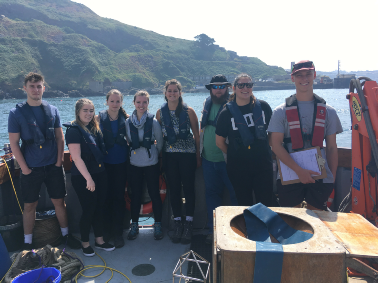
PLYMOUTH 2018

OFFSHORE
OFFSHORE




03/07/2018
The offshore survey using RV Callista aimed to investigate the vertical and horizontal structure of the offshore environment surrounding the Plymouth Sound and estuaries - investigating nutrient, temperature and salinity profiles as well as aiming to determine the characteristic phytoplankton and zooplankton communities at each site sampled. The aim was to gain a greater understanding of water column features around off shore Plymouth. We would hopefully locate the position of the tidal mixing front through investigating stratification and therefore see the interaction of riverine and oceanic inputs as well as physical mixing processes around the Plymouth coast. We would then be able to determine which physical processes dominate Plymouth’s coastal and estuarine mixing and whether this matches with findings from other typical coastal shelf seas. Nutrient profiles were also analysed to investigate the contribution of offshore biological interactions to the water column in the area.

The initial plan was to survey along a transect from just inside the estuary through to L4 and then to E1 (shown in Figure 1), however, due to strong south-easterly winds and inclement weather a different course was taken heading eastward along the coast (see map below for site locations). This restricted the possibility of locating the tidal mixing front between the well-mixed coastal waters and stratified deep waters. However, the weather conditions became more favourable in the afternoon so one set of measurements was able to be collected at L4 (station C7), enabling some extent of investigation of this front.
A CTD rosette was deployed to collect a continuous profile of temperature, salinity, coloured dissolved organic matter, irradiance and fluorescence (used here as a proxy for chlorophyll and therefore phytoplankton) against depth at each of 7 stations, and a ship-mounted ADCP was used to log both the ships track and the flow direction and speed along our course and whilst drifting at each station. Niskin bottles were also fired at select depths at each station and water samples taken and prepped for later lab analysis of chlorophyll-a, nutrients, dissolved oxygen and phytoplankton using methods as described by Strickland and Parsons (1972) [2]. The initial CTD deployment at C2 failed due to
strong winds pushing the boat off-course. This meant the CTD was just trailing behind the boat instead of deploying to depth and so it had to be-deployed. The new deployment at the same location was named C3. A zooplankton net of diameter 0.5m and mesh size 200µm was deployed at two stations – C4 and twice at two different depth ranges at C5.
Figure 1 - location of L4 and E1 [1]

Please click on the locations of each station on the map below to see individual plots for each of them or scroll down for a physical, chemical and biological summary of all the offshore data.
Figure 2 - locations of stations C1-C7 of the offshore survey by RV Callista [3].
The temperature profiles from stations C4, C5, C6, and C7 (located roughly on a transect with increasing distance from the shore) clearly show that with increasing distance from the shore, a thermocline becomes increasingly more present indicating the water column is becoming more stratified. At C4 and C5, due to the unfavourable weather conditions and therefore the CTD bobbing up and down at the surface, surface data contained a lot of noise, which we tried to remove to present a clearer profile.
At C4, increased turbulence associated with shallower depths (22m) and increased tidal and wind forces (associated with proximity to shore) create a well-mixed water column. As the water column deepens (to around 47m) with distance from shore, it becomes more stratified and a seasonal thermocline becomes evident at about 18m and a front forms between the stratified and vertically mixed water. The seasonal thermocline is particularly well-defined at this time year because of the warm air temperatures and increase in solar radiation uncharacteristic for this early in summer. Below the seasonal thermocline CDOM increases from 0.02 to 0.04, likely because of remineralisation. If surveys were carried out later in summer, the thermocline would likely be deeper due to continued heating from the surface warming progressively more of the water column. The formation of vertical stratification is the key physical aspect that allows shelf seas to become an important sink for atmospheric CO2 [5].
At stations C1, C3 and C4, the water column was observed to be well-mixed, so generally the concentration of all nutrients - except silicate - increased with depth. This increased nutrient concentration at depth is likely due to a lower abundance of phytoplankton in deeper waters due to low irradiance levels preventing growth and nutrient uptake and therefore allowing nutrients to be remineralised. The slight decrease in silicate with depth may be due to increased uptake by diatoms, as Si is needed in higher quantities than other nutrients to make siliceous frustules and is therefore remineralised deeper than other nutrients.
At stations C6 and C7, which are further offshore, nitrate levels are minimal at the surface. However, at station C5, which is closer to the shore the surface levels are relatively high. This could be because the levels of phosphate near the estuary mouth are high, despite removal in the upper estuary due to primary productivity. This supports the hypothesis that there are significant anthropogenic inputs of phosphate to the estuary, perhaps from sewage treatment or input of raw effluent. This could also be supported by the well mixed water column observed at C5, which would be recycling nutrients from depths. At C6 and C7, the nitrate levels are characteristic of a stratified surface ocean. The water above the thermocline is depleted of nutrients due uptake by primary producers. The thermocline inhibits mixing so nutrient levels remain at low concentrations above the thermocline as there is not much turnover [6].
The silicate profile for C6 and C7 are similar with a peak in concentration at around 15m, followed by an increase in concentration with depth from about 20/25m. The increase in silicate may indicate a nutricline due to downwards silica flux from the surface mixed layer where diatoms are highly abundant. At C7, nitrate shows a peak at the same depth as silicate. This could mean silicon which is remineralised above the themocline would be taken up by the existing diatom community. However, diatoms have been observed below the thermocline which may indicate additional hydrodynamic subsurface mixing due to meteorological activity.
PYTOPLANKTON
Phytoplankton sampled were obtained using a CTD/ 10L Niskin bottle, subsamples were preserved with Lugol’s iodine solution [7].
Overall 27 different phytoplankton types were identified (The protozoa Radiolaria spp. has been additionally included) 15 of which were identified from sites C5, C6 & C7. The Highest abundance noted was that of Chaetocerotaceae spp. (1790 cells/ml) at C5 which is a chain forming siliceous diatom.
Phytoplankton observed were sub ordered into functional groups (Phytoflagellates, Diatoms, Phaeocystis, Coccolithophorid, Dinoflagellates, Heterotrophic Dinoflagellates and Ciliates) following the method described by Widdicombe et al (2010) ([8]) regularly used to report phytoplankton abundance observed from the time series collected by the Western Channel Observatory. Samples at depth were elucidated to identify within sample sites C5, C6 & C7 the short-term distribution of phytoplankton.
Physical data obtained from sites C1, C2, C3 and C4 showed a well-mixed profile, accompanying this was a homogenous phytoplankton distribution, however at sites C5, C6 and C7 the distribution of phytoplankton indicates some interaction between physical and hydrodynamic parameters most likely associated with stratification rather than mixing indicated by a weak seasonal thermocline between 15-18m where the thermocline was strongest at site C7 showing a temperature difference of 3 degrees.



Dinoflagellates are consistently in higher abundance around the depth of the thermocline in the three stations discussed which may indicate evidence of vertical migration into the mixed layer either caused by dial migration or alternatively this distribution may be attributed to turbulence caused meteorological conditions.
ZOOPLANKTON
Three vertical zooplankton trawls were deployed over Sites C4 and C5 to assess the vertical community composition of zooplankton. A 10m zooplankton trawl net with a diameter of 50cm obtained a 1ltr seawater sample.



Over all stations Copepods are consistently abundant which coincides with diatoms dominating the water column. Grazing activity of diatoms by copepods could indicate the reason for this however a higher resolution analysis of the data is required to support this hypothesis.
Fig.1 Phytoplankton (Cell count/ml sea water) taken from all stations where depth profiles were collected offshore show diatoms and dinoflagellates are the most dominant microoganisms in the water column.

Fig.2 Phytoplankton distribution across all three depths sampled at station C5. Diatoms show the highest abundance at all three sample depths (5m, 20m & 40m). Dinoflagellates show the highest abundance around 20 metres which coincides with the thermocline depth at this station which then declines with depth. Phaeocystis was detected in small volumes near at the water column surface which increases slightly with depth.
Fig.3 Phytoplankton distribution across the 2 depths (15m & 45m) sampled at station C6 show abundance of phytoplankton along the thermocline ~15 metres. Diatoms at this depth dominate the sample along with Phaeocystis but are absent at 45 meters however heterotrophic dinoflagellates were detected in low abundance.
Fig.4 Diatoms dominated the samples taken at Site C7 ( 15m, 17m & 21m) with a high but singular occurrence of heterotrophic bacteria occurring in the surface waters.
Fig.5 Site C4 shallow zooplankton trawl abundance. This trawl shows the community composition from a vertical trawl from 20m to the surface, mysidacea, copepods and copepod nauplii were the most abundant organisms at this site.
Fig.6 Site C5 Deep Zooplankton Trawl abundance shows a more diverse community composition from a vertical trawl from 40m to 20m, decapoda larve, copepoda and echinoderm larve are the most abundant larve at this site.
Fig 7 Site C5 shallow Zooplankton Trawl abundance shows a smaller community composition from a vertical trawl from 20m to surface mostly consisting of cladocera, copepoda and copepoda nauplii.
Skip to: PHYSICAL CHEMICAL BIOLOGICAL findings
REFERENCES
[1] Google Earth
[2] Strickland, J. and Parsons,T. (1977). A practical handbook
of seawater analysis. Ottawa: [Queen's Printer].
[3] Google Earth
[4] with
stronger tidal influence causing a more well-established front [4] (Plymouth, 2012)
[5]
Painter et al., 2016
[6] Hutchings et al., 1995
[7] Throndsen J., (1978)
Preservation and storage. In: Sournia A (ed) Phytoplankton manual. UNESCO, Paris,
p 69–74
[8] Widdicombe C et al., (2010) Long-term phytoplankton community dynamics
in the Western English Channel. Journal of Plankton Research, 32(5), 643
Or for all references together, see our reference page - here.

| Our Findings Home |
| Offshore |
| Estuary |
| Geophysics |
| C1 |
| C2/3 |
| C4 |
| C5 |
| C6 |
| C7 |
| Falcon Spirit |
| Winnie the Pooh |
| Pontoon |